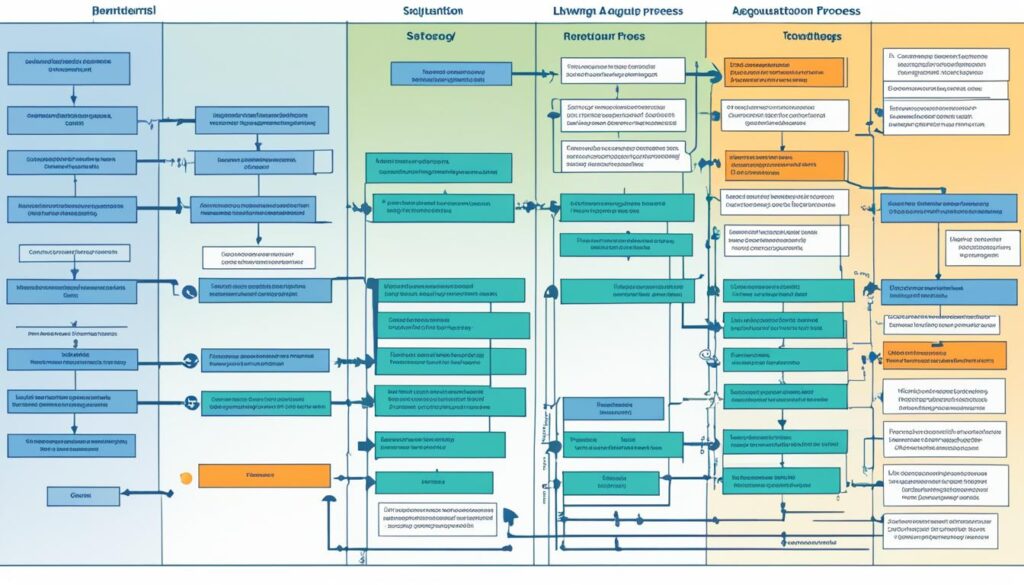A well-planned software acquisition sets successful businesses apart. Today’s tech world is complex, making a smart procurement strategy crucial. Companies must navigate through numerous software vendors wisely. They can seek wisdom from sources like the Defense Acquisition University’s Defense Acquisition Guidebook. This guide helps businesses create plans that meet their goals, lower risks, and follow rules.
Key Takeaways
- Effective software acquisition planning hinges on a proactive approach that considers the current and future technological needs of a business.
- Having a sound software procurement strategy in place aids in risk mitigation and fortifies a program’s chances of success.
- Making informed decisions during software vendor selection is critical to aligning technology with business objectives and operational requirements.
- Incorporating insights from industry best practices ensures that the procurement process is transparent, efficient, and compliant with regulations.
- The appropriate integration of market research with stakeholder collaboration is essential for a comprehensive acquisition outcome.
- Software procurement and vendor selection should prioritize not just immediate needs but also long-term support and maintainability.
The Significance of Early Software Acquisition Planning
Starting with early software acquisition planning isn’t just a first step. It’s a smart strategy that boots the whole technology purchasing process. It helps organizations move through the tricky parts of buying technology. With good planning, they can do this smoothly and accurately.
Identifying the Need for Software Early On
Figuring out software needs early helps companies look at many options. They make sure the chosen technology meets current and future needs. This smart planning makes adding new software smooth.
Strategic Timing and Fiscal Planning
Getting the timing right is key in buying technology. By planning with the budget in mind, businesses can make the most of their money. They follow software purchasing guidelines to buy at the best time. This makes sure they have money for important updates.
Aligning Acquisition with Business Objectives
For technology buys to help a company stay ahead, they must fit with the big picture goals. This means thinking about costs over time, how the technology can grow, and how it helps reach long-term goals. Doing this boosts productivity now and spurs innovation later.
| Planning Phase | Objective | Benefits |
|---|---|---|
| Early Needs Assessment | Understand the end-user requirements | Higher satisfaction, Custom-fit solutions |
| Fiscal Alignment | Match procurement with budget cycles | Cost-effective spending, Reduced fiscal stress |
| Business Goals Integration | Ensure software serves strategic purposes | Increased competitiveness, Better ROI |
In conclusion, early software acquisition planning is crucial for many reasons. It involves good timing, responsible budgeting, and smart strategizing. With these steps, companies can make their technology investments pay off. They’ll see progress and better performance.
Formulating a Robust Software Procurement Strategy
The base of a software procurement strategy comes from knowing what tech the company needs. It looks ahead at the IT future. When team members follow IT procurement best practices, they ensure a smooth process. This process meets and even tops what’s expected. It’s crucial to plan how to match IT stuff with business aims.
To make any plan work, mix different elements like open systems, ready-made (COTS) systems, and strong software designs. The heart of keeping software purchases up is focusing on maintenance. This includes protecting operational data and keeping info safe. These steps are key to keeping business running smoothly.
It’s vital to stick to key practices like setting requirements, testing software, managing risks, and using clear performance rewards. Picking software sourcing strategies that are both stable and adaptable helps. These strategies match the changing needs of IT and tackle challenges well.
The Software Engineering Institute (SEI) offers great insights. They help businesses move through the complex world of software buying with ease.
Here’s a table that shows important bits of IT procurement practices:
| Best Practice | Description | Benefits |
|---|---|---|
| Open Systems Approach | Using open standards and adaptable systems. | More working together and easier updates in the future. |
| COTS Utilization | Using solutions that are already out there. | Saves money and speeds up making things. |
| Robust Software Architecture | Making a flexible and strong design. | It lasts longer and is less complicated. |
| Information Assurance | Putting in security to keep data safe and there when you need it. | Lowers the chance of data problems and follows the rules. |
Using these practices in a software procurement strategy makes the process more trusted. It also keeps software investments good for the long run.
A well-thought-out plan pays attention to the latest in the industry and new sourcing ways. This could be key to a software setup that perfectly fits a business’s goals and tech path.
Software Acquisition Planning: Crafting Your Approach
Navigating the software acquisition lifecycle is like a complex dance. Each step is planned and executed with care. This aligns the buying of software systems with major business goals. It’s about balancing the rules of buying software with the needs of the organization.
To nail it, businesses must follow program management guidelines. They should keep an eye on software development and acquisition. Making a detailed plan is more than just ticking boxes. It means really understanding the goals. And, creating a specific plan to manage risks for the best results.
“An effective software acquisition strategy is key for successful technology use. It strengthens the framework for managing risks. And, it makes sure buying processes match with the company’s main goals.”
- Comprehensive Requirement Analysis: It’s crucial to match acquisition with business needs.
- Risk Management Strategies: Needed to foresee and lessen problems during the process.
- Performance Milestones and Monitoring: Important for keeping track of progress and adjusting as needed.
- Stakeholder Engagement: This ensures good communication and understanding between everyone involved.
Improving the acquisition strategy requires using specialized knowledge. Resources like the SEI’s handbook provide insights. They talk about the dos and don’ts of buying, with examples to help you.

In summary, buying software systems might seem tough. But, with a smart and informed approach, it can bring big rewards. By following guidelines for software purchasing, companies can move towards a successful acquisition. This supports continuous growth and innovation.
The Importance of Vendor Selection in Technology Purchasing
Choosing the right software vendor is a key step in the tech buying process. It goes beyond simple procedures. It’s a vital choice that guides the success of a project. When looking for software, it’s important to use strategies that check vendors from all angles. The best results happen when a company’s goals and a vendor’s creativity match well.

Assessing Vendor Capabilities and Compatibility
Understanding a vendor’s skills is the first step in choosing software. This means looking at their history, knowledge, and ability to meet unique project needs. A good fit between the vendor’s products and a company’s current and future needs is crucial. This evaluation comes from deep discussions, industry involvement, and looking at past vendor performances.
Understanding Vendor Support and Sustainment Policies
It’s important to know how a vendor supports and maintains their software. Long-term support, like updates and customer service, helps prevent technology from becoming outdated. It also protects your investment. Plus, it keeps work flowing smoothly as software changes, helping a strong partnership last through the software’s life.
| Selection Criteria | Questions to Ask | Desired Outcome |
|---|---|---|
| Technical Expertise | Does the vendor have a proven track record with similar project scopes? | Assurance of high-quality solution delivery |
| Integration Potential | Can the vendor’s product seamlessly integrate with current systems? | Smooth transition and adoption of new software |
| Long-term Support | What kind of support and maintenance does the vendor offer? | Reliable service throughout the software’s lifecycle |
| Customization | Is the vendor willing to tailor software features to specific needs? | A software solution that aligns perfectly with business requirements |
| Financial Stability | Is the vendor financially secure and likely to be long-standing? | Risk mitigation regarding vendor longevity |
Working together closely and keeping communication open is key in buying technology. This partnership goes beyond just buying and selling. It lays the groundwork for tech growth and innovation. Choosing a software vendor carefully, with a clear plan and thoughtfulness, is crucial. It ensures that today’s tech investments will pay off in the future.
Software Acquisition Lifecycle and IT Procurement Best Practices
The journey through the software acquisition lifecycle is complex. It requires strict adherence to IT procurement best practices. It’s more than a straight path—it’s a cycle of constant checking and getting better, which is crucial for a successful software procurement strategy. In this section, we explore vital steps of the cycle. We also look into how following best practices shapes the process of getting software, helping organizations work better and succeed.



